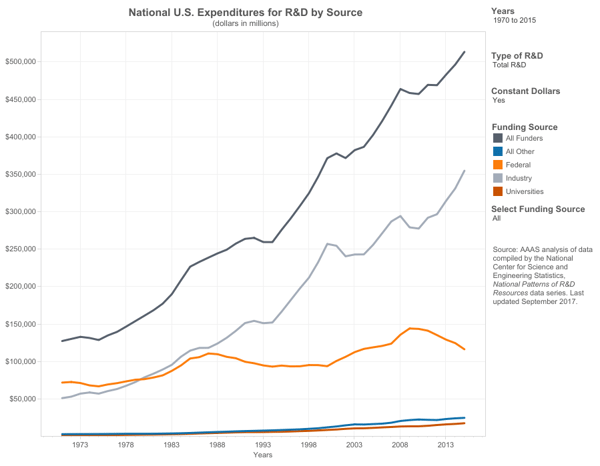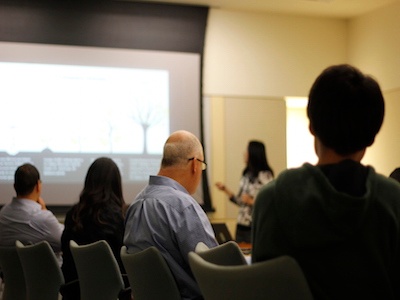It’s no secret that scientific research is becoming less of a priority to the federal government. For two decades, research and development (R&D) funding has remained stagnant or dropping, despite increases to the overall federal budget. With a growing population of scientists entering the field, a lack of funding generates a hyper-competitive and stressful funding climate. For those looking to secure funding for the first time, or simply curious about how science is funded, this post serves as an introductory guide.
- Who Funds Science?
- Where Does the Money Go?
- Science in 2019 (Trump's Budget Proposal)
- Finding Grants for Your Research
Who Funds Science?
Research and development funding in the U.S. typically comes from four main entities: the government, industry (private, for profit companies) and, to a lesser extent, higher education and non-profit organizations. Previously, the majority of science funding came from the federal government, but those days are long gone. For better or worse, industry now greatly supersedes the government in scientific funding, particularly in areas like applied research and development. According to the latest data from the American Association for the Advancement of Science (AAAS), industry contributed three times as much as the government ($354,693 million vs. 116,300 million) to R&D in 2015.

Industry vs. Federal Funding (a tangent)
Industry’s growing presence in research and development raises concerns about the impartiality of study outcomes. For example, in industry-funded clinical trials, there is evidence of biased reporting, such as higher reports of positive or favorable results. However, given lack of federal funding, it is not a simple decision to turn down industry support. It bears repeating that industry commitment is now, by far, the leading contributor to scientific research in the U.S. An article in The Conversation explores the debate over whether there should be industry involvement in science.
“On the face of it, partnerships between academia and industry in the production of knowledge are both sensible and critical. Given sluggish economic growth and the prevalence of societal problems that require technological solutions, one might argue that universities should be extensively engaged in contributing to innovation and less concerned with research lacking an apparent connection to real-world impact.”
– The Conversation
Where Does the Money Go?
Funding largely comes from industry and the federal government, but where exactly does that money go? According to 2016 data from the latest AAAS report, 63% of all R&D funding went to experimental development, which is work that draws on research and practical experience, but is directed towards producing and improving products. Applied research, with practical objectives, received 20% of R&D funding, while basic research, carried out for pure knowledge and understanding of fundamental science, received 17%. In the chart below, you can explore the amount of money in current millions that was allocated to each sector by the four main funding entities.
Science in 2019: Trump's Budget Proposal
In 2018, less than 3% of the entire federal budget was spent on research and development. Despite Congress’ intervention which rejected Trump’s original budget cuts (such as the 17% cut to basic research), the final number is still disconcertingly low.
The 2019 fiscal year is now right around the corner and with it is the POTUS' new budget proposal. Aside from a 1.8% increase for development, the new proposal once again requests budget cuts to applied and basic research. Currently, the proposal requests a 8.1% cut to basic research and a 16.2% cut to applied research. You can access the complete, detailed breakdown of 2019's R&D funding proposal.
Finding Grants For Your Research
For those entering the field (i.e. graduate students, post-doctorates, and assistant professors), navigating the grant application process is undoubtedly daunting, especially because there are so many federal agencies, each with their own funding schemes and deadlines. Finding suitable grants to apply to can be a beast in and of itself. Where does one begin? Below, we rounded up the best, free-to-use websites to find funding opportunities.
- Grants.gov – Perhaps the most encompassing of the sites on this list, Grants.gov allows users to search for grant opportunities from the most important R&D federal funding agencies in the U.S.
- CRDF Global – CRDF Global is unique on this list because it is an independent, nonprofit organization. Its grants are available to scientists and innovators in over 40 countries. However, it is particularly focused on scientific collaborations and projects aimed at solving global issues, such as global health; nuclear, biological and chemical security, and water, food, energy nexus.
- NSF – The National Science Foundation offers a variety of grants throughout the entire year. The NSF funds approximately 24% of federally supported basic research. In 2017, the majority of NSF’s funding (78%) supported research in colleges, universities, and academic consortia.
- NIH – If your work is in the realm of biomedical research, you probably already know of the National Institute of Health. Their website allows you to search for any of their grants, which typically fall into one of 11 categories. New scientists should definitely make a note of NIH’s grants geared for “early science investigators” (ESI) or “new investigators.” You can also indicate your ESI status on the NIH’s oldest and most commonly used grant program, the R01.
Conclusions and further thoughts
Securing government grants has become an incredibly and increasingly difficult process for scientists. Understanding how funding works in the current climate is an important foundation for scientists just entering the field. As funding stagnates, it is also important to think about how increasing pressure to produce "useful" data and "impactful" studies may lead to problems such as biased funding, questionable authorship practices, and reproducibility crises.

.jpg)


.png?width=600&name=The%20Federal%20Budget%20Overall%20(1).png)



